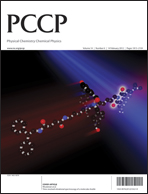On the analyses of fluorescence depolarisation data in the presence of electronic energy migration. Part I: Theory and general description
Abstract
A new and general procedure is described for a detailed analysis of time-resolved fluorescence depolarisation data in the presence of electronic energy migration. An isotropic ensemble of bifluorophoric molecules (D1–R–D2) has been studied to demonstrate its utility. Intramolecular donor–donor energy migration occurs between the two donor groups (D), which are covalently connected to a rigid linker group (R). These groups undergo restricted reorientational motions with respect to the R group. The analysis of depolarisation data basically involves the search for best-fit parameters which describe the local reorientational motions, the intermolecular D1–D2 distance, as well as the mutual orientations of the donors. For this, the analysis is partly performed on the Fourier domain and the best-fit parameters are determined by using an approach based on a Genetic Algorithm. The energy migration process has been described by using Monte Carlo simulations and an extended Förster theory (EFT). It is found that the EFT provides the least time-consuming computational method. Since one-


 Please wait while we load your content...
Please wait while we load your content...